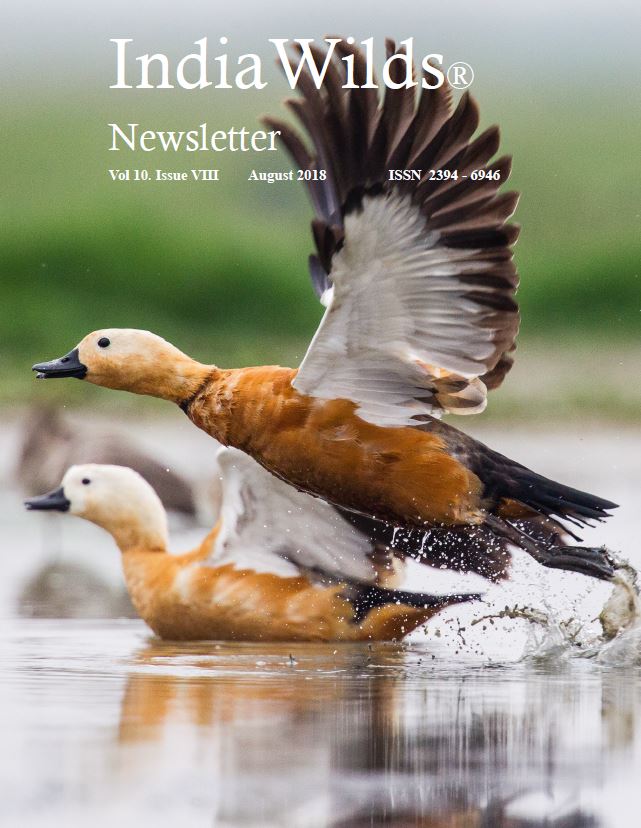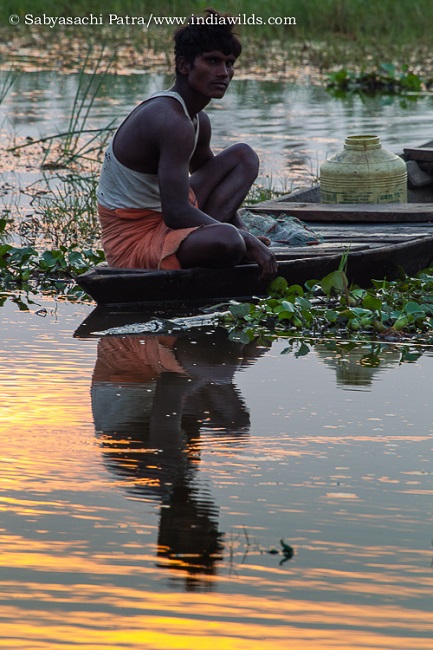IndiaWilds Newsletter Vol. 10 Issue VIII
ISSN 2394 – 6946
Save Chilika from Seaplane Project:

IndiaWilds Newsletter-August-2018
Development vs Conservation is a slogan which has often caused the death knell of many ecologically fragile lands because people immediately get convinced by the usage of the word develop as it connotes something good and better. Any infrastructure creation is seen as development, howsoever detrimental it might be to the place.
Some localities and villages fight against setting up wine shops. At times they succeed because those shops are seen as a social evil. Our brains are conditioned to believe that alcohol is bad. Else, that would have been seen as development.
There was a time when traveling by flight was seen as elitist. People used to wear their best/only suit as the case may be to travel by air. Though the advent of cheap low cost airlines and in some cases their employees beating up passengers have removed the sheen from air travel a bit. Nevertheless, the very mention of setting up an aerodrome is seen as a positive sign. And when people hear that Seaplanes have to land at a place and facilities need to be created for that, they immediately take it as a positive sign.
Alas! Not many realise that setting up such a project in the biodiversity rich place like Chilika lake, which is a wetland of international importance and is recognized as a Ramsar site in 1981, is not “Development”. It is a retrograde step.
Chilika lake is no ordinary waterbody. It is spread over nearly 1100 square kilometers covering Ganjam, Khordha and Puri districts of Odisha. It is the largest brackish water lake in India and one of the top coastal lagoons in the world. It is brackish in nature and estuarine in character. 52 rivers and rivulets feed Chilika. Hence the size of the lake varies based on season, ranging from 900km to 1165 kms at its peak.
The Chilika lake has marine, brackish and freshwater ecosystems and it supports amazing biodiversity. Due to the variety of habitats the relationships between the various species ie plants, birds, invertebrates, vertebrates etc is complex. Over 800 species of flora, fauna (vertebrates, invertebrates) as well as avian species are found.
There are about 160 dolphins in the Chilika lake. The endangered species found in the lake also include a species of limbless skink which was accidentally discovered. And there is every chance that in such a vast area, there may be other species yet to be discovered if proper scientific investigations are permitted over a longer period of time.
Chilika also has a role in Odisha history. Between 1568 and 1733 AD Odisha was repeatedly attacked by muslim invaders. So Lord Jagannatha was for sometime hidden in Gurubai island and chadheihaga hill in Chilika. So the Chilika lake is also important to the people of Odisha from a religious-cultural angle.
Since time immemorial, Chilika lake is known for its beauty. There are many poems, stories and plays written on Chilika and has inspired many folklores. In one of the famous poems Utkalamani Gopabandhu Das while being taken to Berhampur Jail by a train was bowled over by the beauty of Chilika. So he exhorts the steam engine driven train to stop for a moment so that he can soak in the beauty of the lake.(In odia he writes “raha raha kshane baspiya sakata, dekhibi chilika charu chitrapata”). His poem has inspired many people and they in turn yearn to see its beauty. Today, Chilika is an important spot for picnic and sightseeing and many tourists visit it to watch migratory birds in winter as well as to watch the dolphins.
It is estimated that in some years close to million migratory birds visit chilika in the winter. There is a very important role of these birds in shaping the ecosystem of chilika lake. Their guano deposited into the lake helps in nutrient recycling. The bird droppings from the ducks and geese have an estimated 33.8 tons of Nitrogen and 10.5 tons of Phosphorus and helps in the high biomass production of macrophytes and increases the fish productivity.
Birds feed on the vegetation and this help in pruning and maintaining the fresh sprouting of tender shoots and leaves. This fresh growth benefits the fish and invertebrates. Thinning of vegetation by the waterbirds also enables the free movement of fish in dense vegetation.
The complex relationship of these feathered beauties with the ecosystem of chilika results in higher fish productivity for the fishermen. An estimated 2 lakh fishermen depend on Chilika directly for their livelihoods. Along with other dependents and middle men and vendors, the multiplier effect of Chilika lake on the economy of Odisha is huge. If birds come in reduced numbers, then the impact on the fish will also be severed. So it is expected that no sane Government would try to mess up with this scenario.

Fisherman in Chilika
It should be pertinent to mention that In 1993 Chilika lake was included in the Earlier when Chilika lake The lake was included in the Montreux Record (Threatened list) in 1993 by Ramsar Secretariat due to the change in the ecological character of the lake ecosystem. However due to the successful efforts led by Chilika Development Authority (CDA), Chilika lake was removed from the Montreux Record in 2002 as the health of the ecosystem was restored back. So any important event concerning the health of Chilika should also be verified with the CDA. However, it seems one arm of the Government doesn’t know what the other is doing. CDA has got not official information about such plans.
The Government has gone ahead and announced that it will allow Seaplane service in Chilika lake. Seaplanes are typically 8-9 seater planes which have a huge float underneath and hence can take off and land in water. To jog your memory, Sylvester Stallone and his bunch of mercenaries use such planes in their series of Hollywood films titled “Expendables” where this bunch of mercenaries use such planes to land at some waterfront and fight and plunder (for a good cause) and rush back in time to flee using the seaplane.
The Seaplanes with a few such luxury tourists will now routinely land in Chilika. A layman may ask what is the need? The Bhubaneshwar airport is barely one and half hours drive. So what is the need for a seaplane service? Clearly it is not a need, but it is a case of have money, so I will have pleasure wherever I want. And perhaps it is a case of creating some opportunities for some industries.
Throughout the world, airports are worried about birds and the damage that a plane can suffer due to birdhits. Some airports are in news for not only spraying pesticides to kill insects so that birds are not around but also flying falcons to scare away birds and even bursting crackers etc to ensure that birds are not there. Slaughterhouses, dump yards etc are also removed so that birds are not seen around the airports. So why do you want to fly into millions of birds? That means the bird habitat will be so modified that birds will stop visiting the place to remove the fear of bird hits? The Government is yet to answer these questions.
No Environmental Impact Assessment has taken place. As such the way EIAs are conducted is a joke. So I am sure some agency can always come out with a report stating that seaplane service is fine. As such there are some people who are asking since the Chilika lake is so vast what is the problem in sacrificing a small part of it. The fact is it may appear as vast, however it is like asking whether a person can survive without an organ like fingers or hands or feet. People do survive. However, God hasn’t designed us with all our organs and it makes for a healthy human being. Similarly, when you dismember an ecosystem by removing a part of it, the ecosystem will not be healthy at all. Our scientists are still trying to unravel the complex interdependencies of various species. So it would not be prudent to argue to destroy a part of a healthy ecosystem.
There is also an argument that not many people will use it. So why bother. Today the technology may be for smaller planes. It can always change. The damage can only increase over a period of time and not reduce. There would be many such operators in future operating from different areas in Chilika. No one knows what is in store in future.
Once the permission is given, the seaplane service operator will later come out of the argument that they have invested so much of money and hence it will be used for all kinds of events irrespective of the damage that it causes to the environment. This will become a permanent feature and it would be tough for Chilika to recover.
The problem is the Government is opening the floodgates and giving all kinds of permission. MoEF&CC, the ministry which is supposed to be the guardians of our environment and wildlife is behaving like a clearing house of projects. So don’t expect that MoEF&CC will object to the seaplane project inside Chilika lake. So it is important for people to fight to save their natural and cultural heritage as well as livelihoods.
Please raise your voice to Save Chilika by writing to your local representatives as well as to Odisha’s Chief Minister, Union Civil Aviation Minister, Union Environment minister as well as to the hon’ble Prime Minister of India. Also please don’t forget to spread the word.
Write/tweet/email to:
Shri Narendra Modi
Ho’ble Prime Minister of India
Tweet: @narendramodi
And tweet to the PMO at @PMOIndia
Email: pmosb@pmo.nic.in
Tel: +91-11-23012312
Fax: +91-11-23016857
Shri Naveen Pattnaik
Hon’ble Chief Minister of Odisha
Tweet: @Naveen_Odisha
Email of CMO: cmo@nic.in
Twitter of CMO: @CMO_Odisha
Dr. Harsh Vardhan
Hon’ble Minister for Science & TEchnonology, Earth Sciences & MoEF&CC
Email: dr.harshvardhan@sansad.nic.in
Tel: +91-11-24695136, 24695132
Fax: +91-11-24695329(Fax)
Shri Suresh Prabhu
Hon’ble Minister for Civil Aviation
Twitter: @sureshpprabhu
Email: hm.moca@nic.in
Flood Fury: Will we learn from Kerala & Kodagu?
Conservation News:
Second tiger released into the wild in Satakosia:
A tigress nick named Sundari which was brought from Bandhavgarh and was kept in an enclosure has been released into the wild on 17th of August. This tigress code named T-412 was relocated from Bandhavgarh on 28th June. There was considerable disquiet among conservationists and researchers regarding the lengthy incarceration, as this tigress was kept in an enclosure. A wild tiger shouldn’t be kept in an enclosure for long.
The authorities had to grapple with the demonstrations by locals in Angul, where many residents of nearby villagers had gathered to protest against the tiger relocation. People were fearful that because of presence of tiger their illegal entry into the forest to collect forest produce as well as poaching will become a problem. Villagers also fear that their livestock which routinely graze inside the forest will be killed by tigers. So they had threatened to poison and kill the tigers. Any tiger death would have been a big problem for the authorities. Taking into consideration the protests by locals the Madhya Pradesh Government had already stopped further relocation of tigers. The third tiger which was to be shifted to Satkosia from Kanha has now been shifted to Sanjay Duburi National Park.
The plan was to relocate three pairs of tigers to Satkosia in two years time. However, the future of this relocation project is uncertain due to protests from locals. The Tiger Reserve authorities have to do a massive PR exercise to educate people the benefits of having tigers in a forest as that would attract more tourist revenue. The existing ecotourism project will become popular and more people will find work. If there is any livestock killing then the forest department will have to immediately provide compensation. More of local people should be taken under contract as watchers. That would provide them employment as well as help in securing the forests.
The Odisha Government is taking this relocation seriously. During the release of the tigress Sundari, the Principal Chief Conservator of Forests (PCCF), APCCF and other top officials, researchers of Wildlife Institute of India and other top officials were present. With this there is now one pair of tigers for breeding in the park.
Once the good news about the wellbeing of this pair of tigers is known, we hope the Odisha Government will be able to convince the Madhya Pradesh Government to provide more tigers. This will help in creating a healthy gene pool.
Compensatory Afforestation Fund rules notified:
The compensatory afforestation fund rules have been notified on 10th of August, 2018. The Compensatory Afforestation Bill was passed in July 2016. It specifies the activities that would be allowed. Under the Forest Conservation Act (1980), any forest land that is diverted for non-forest use like mining, roads, railways, canals, dams or other such industrial or linear projects will be compensated for by paying a certain amount to the CAF (Compensatory Afforestation Fund) which will be equal to the NPV (Net Present Value) of the forest land being divested. This money will then be used to create forests.
The CAF Bill was first passed in Lok Sabha in 2008. However, it could not be passed in the Rajya Sabha. The Narendra Modi Government after coming to power in 2014 introduced the CAF bill in 2015 and finally it was passed in 2016. It became an Act in August 3, 2016. Now that the CAF rules have been notified, the CAF Act will come into force from September 30, 2018.
The CAF has over 52,000 crores of rupees in it lying idle. Speaking about it, the Union minister for MoEF&CC Dr. Harsh Vardhan said that the release of fund to States will boost the efforts of the Government towards restoration and enhancement of forest wealth, enhance bio-richness, water availability and secure ecological security of the country, adding that this effort will help in creating the additional carbon sink to meet the nation’s Intended Nationally Determined Contribution (INDC) of 2.5 to 3 billion tonnes of carbon dioxide equivalent through additional forest and tree cover by the year 2030.
The Minister also pointed out that the publication of the CAF Rules will pave the way for smooth transfer of funds worth about Rs. 52, 000 crore to the States. He also said that the fund will be kept in the interest-bearing Public account of the Centre and States, will be safe and will be used only for compensatory afforestation, soil moisture conservation, wildlife management and catchment area treatment. The Minister also said that these activities will be managed by statutory body called National Authority and State Authority and has a strong monitoring mechanism.
Till now this fund was being managed by Compensatory Afforestation Fund Management and Planning Authority (CAMPA). “The release of the fund was restricted to only 10% of principal amount from interest accrued over it. Now, the Fund will be managed as per the CAF Act and Rules, unlocking the use of funds collected for the purpose of forest ecosystem restoration and water security”, Dr. Vardhan averred.
He stressed that the Act provides that the Compensatory Afforestation will be compulsorily undertaken from the funds deposited for compensatory afforestation only on priority. The Minister said that this legislation will provide funds to the State Governments, which will get 90% of their share of funds – about Rs. 52, 000 crore to plan better and utilize the fund for compensatory afforestation, conservation of wild flora and fauna, wildlife habitat management and regeneration of degraded forest and restoration of ecosystem services.
The Minister also pointed out that it has been provided that the expenditure can be done as per Annual Plan of Operation (APO), prepared in consultation with Gram Sabha to ensure that the rights of tribal population are protected. “With this objective in view, the afforestation of indigenous plant species has been proposed”, Dr. Vardhan added.
The forests rights activists accuse the Government of trying to bypass the Gram Sabhas in the implementation of the Compensatory Afforestation Fund. The other challenge is availability of suitable land. In many cases, the forest department is accused of clear felling existing forests and then allowing plantations in those in the name of CAF. We Indians are known to find loopholes and exploit it. So CAF Act and Rules also will provide many such opportunities. We hope the Government continues its dialogue with local communities and researchers to understand the problems and create amendments wherever it is due.
Khangchendzonga becomes 11th Indian Biosphere reserve to be part of WNBR:
The Khangchendzonga Biosphere Reserve has become the 11th Biosphere Reserve from India that has been included in the UNESCO designated World Network of Biosphere Reserves (WNBR). The decision to include Khangchendzonga Biosphere Reserve in WNBR was taken at the 30th Session of International Coordinating Council (ICC) of Man and Biosphere (MAB) Programme of UNESCO held at Palembang, Indonesia, from July 23-27, 2018. India has 18 Biosphere Reserves and with the inclusion of Khangchendzonga, the number of internationally designated WNBR has become 11, with 7 Biosphere Reserves being domestic Biosphere Reserves.
Khangchendzonga Biosphere Reserve in Sikkim is one of the highest ecosystems in the world, reaching elevations of 1, 220 metres above sea-level. It includes a range of ecolines , varying from sub-tropic to Arctic, as well as natural forests in different biomes, that support an immensely rich diversity of forest types and habitats.
The core area of the Biosphere Reserve is a major transboundary Wildlife Protected Area. The southern and central landscape, which makes up 86% of the core area, is situated in the Greater Himalayas. The northern part of the area accounts for 14% is characterized by trans-Himalayan features. Buffer zones are being developed to promote eco-tourism activities. Plantation and soil conservation work is also being carried out.
The core zone – Khangchendzonga National Park was designated a World Heritage Site in 2016 under the ‘mixed’ category. Many of the mountains, peaks, lakes, caves, rocks, Stupas (shrines) and hot springs function as pilgrimage sites. Over 118 species of the large number of medicinal plants found in Dzongu Valley in north Sikkim are of ethno-medical utility. The transition zone is targeted for eco-development activities, afforestation, plantation of medicinal herbs and soil conservation measures.
Single Window Clearance for Environmental projects launched:
The Prime Minister, Shri Narendra Modi, launched PARIVESH (Pro-Active and Responsive facilitation by Interactive, Virtuous and EnvironmentalSingle-window Hub) on the occasion of World Biofuel Day on 10th of August, 2018.
In a series of tweets, Union Minister for Environment, Forest and Climate Change, Dr. Harsh Vardhan highlighted that PARIVESH automates the entire process of submitting the application and tracking the status of such proposals at each stage of processing. Dr. Vardhan emphasised that with the launch of PARIVESH, the vision of the Prime Minister for E-Governance and enhancing Ease of Doing Responsible Business is being translated into action by MoEF&CC. He said that with PARIVESH, MoEFCC has become more of a facilitator, than a regulator. The Minister said that “PARIVESH” is a workflow based application, based on the concept of web architecture. He pointed out that it has been rolled out for online submission, monitoring and management of proposals submitted by Project Proponents to the Ministry of Environment, Forest and Climate Change (MOEFCC), as well as to the State Level Environmental Impact Assessment Authorities (SEIAA), to seek various types of clearances (e.g. Environment, Forest, Wildlife and Coastal Regulation Zone Clearances) from Central, State and district-level authorities. He said that the system has been designed, developed and hosted by the Ministry of Environment, Forest and Climate Change, with technical support from National Informatics Centre, (NIC), New Delhi.
The Minister said that the main highlights of PARIVESH include – single registration and single sign-in for all types of clearances (i.e. Environment, Forest, Wildlife and CRZ), unique-ID for all types of clearances required for a particular project and a single Window interface for the proponent to submit applications for getting all types of clearances (i.e. Environment, Forests, Wildlife and CRZ clearances). Highlighting that PARIVESH offers a framework to generate economic growth and strengthens Sustainable Development through EGovernance, he also stated that with automatic highlighting of non-compliance by the system, PARIVESH helps in improving the overall performance and efficiency of the whole appraisal process.
The Minister highlighted that PARIVESH also helps the processing authorities, as it has a Single Window System for Central, State and District level clearances, auto-generation of agenda (based on first come, first served principle), minutes of the meetings and online generation of approval letters, resulting in ease and uniformity in processing of clearance applications, online submission and monitoring of compliance reports including geo-tagged images of the site by regulatory body / inspecting officers even through the Mobile App for enhanced compliance monitoring. He added that the facility of Geographic Information System (GIS) interface for the Appraisal Committee will help them in analyzing the proposal efficiently, automatic alerts (via SMS and emails) at important stages to the concerned officers, committee members and higher authorities to check the delays, if any. “PARIVESH enables project proponents, citizens to view, track and interact with scrutiny officers, generates online clearance letters, online mailers and alerts to state functionaries in case of delays beyond stipulated time for processing of applications”, Dr. Harsh Vardhan said.
The Government claims that PARIVESH is a Single-Window Integrated Environmental Management System, developed in pursuance of the spirit of ‘Digital India’ initiated by the Prime Minister and capturing the essence of Minimum Government and Maximum Governance. Critics say that MoEF&CC is opening the floodgates and becoming a rubber stamp for all environment and wildlife clearances.
India’s wildlife and its forests is not just a commodity but a natural heritage. The wellbeing of all species and humans are intricately linked with a healthy ecosystem. Especially in the era of Climate Change where sudden massive rainfall, draught and natural calamities have become the norm, tinkering with India’s forests, rivers, lakes, wetlands and other ecologically fragile areas should be done with abundant caution. In July, the Union Cabinet Minister for MoEF&CC Dr. Harsh Vardhan had said that Climate Change is a moral and ethical responsibility. However, by blindly automating the clearance process with focus on speed of clearance rather than focusing on saving India’s natural heritage clearly shows that the Ministry of Environment & forests is presiding over the decimation of Indias natural wealth. Industries will be happy. However, India will be poorer and will suffer for such hasty decisions.
Funds for Prevention of Pollution in Lakes, Rivers and Ground Water:
In a written reply to the Parliament, Union Minister of State for MoEF&CC Dr Mahesh Sharma has said that to fight pollution of rivers, lakes and ground water pollution, the primary responsibility of setting up and processing sewage treatment is of the State Govts. and local bodies. “Pollution abatement of rivers and lakes is a continuous and ongoing process. It is the responsibility of the State Governments/ concerned local bodies to set up facilities for collection, transportation and treatment of sewage for abatement of pollution of rivers & lakes. The Union environment Ministry has been supplementing the efforts of the State Governments in abatement of pollution in rivers under the scheme of National River Conservation Plan (NRCP) and conservation & management of lakes & wetlands under a separate scheme of National Plan for Conservation of Aquatic Eco-systems (NPCA), on a cost sharing basis between the Central and State Governments.
NRCP {excluding Ganga and its tributaries, which are handled by Ministry of Water Resources, River Development & Ganga Rejuvenation (MoWR,RD&GR) from 01/08/2014 onwards} has so far covered polluted stretches of 32 rivers in 76 towns spread over 14 States in the country at a sanctioned cost of Rs. 4581.91 crore and Central share of Rs. 2258.72 crore has been released to the State Governments for implementation of various pollution abatement schemes. Sewage treatment capacity of 2472.43 mld (million litres per day) has been created so far under the NRCP. During the last three years and current year, Central share of Rs.351.87 crore has been released to various State Governments, for pollution abatement of rivers under NRCP. No funds have been released to Jharkhand during the last three years and current year under NRCP.
State Governments, apart from their own budgetary allocation, are also accessing financial assistance for creation of sewerage infrastructure, including Sewage Treatment Plants (STPs), in various cities/towns under Atal Mission for Rejuvenation and Urban Transformation (AMRUT) and Smart Cities Mission of Ministry of Housing & Urban Affairs as well as Namami Gange programme of Ministry of Water Resources, River Development & Ganga Rejuvenation (MoWR,RD&GR). During the last three years and current year, Central funds of Rs.3696.49 crore has been released to various State Governments/State Programme Management Groups/other executing agencies of State Governments by National Mission for Clean Ganga (NMCG) of MoWR,RD&GR under the Namami Gange programme, which includes Rs.82.08 crores to Jharkhand.
NPCA has so far covered 148 identified wetlands and lakes in 24 States & 1 Union Territory and Central share of Rs. 893.69 crore has been released so far to the State Governments. During the last three years and current year, Central share of Rs.158.70 crore has been released to various State Governments. No funds have been released to Jharkhand during the last three years and current year under NPCA.
The MoWR, RD&GR is also implementing the scheme of Repair, Renovation and Restoration (RRR) of water bodies, including ponds and tanks, which aims at improving catchment areas of tanks commands, increase in storage capacity, ground water recharge, improvement in agriculture and increased availability of drinking water.
Central Ground Water Board (CGWB) under MoWR, RD&GR is implementing the ‘Ground Water Management & Regulation’ scheme, under which studies on monitoring, analyzing and mapping of ground water quality and other preventive steps are taken up throughout the country, including Jharkhand. Under this programme, an amount of Rs.526.64 crore has been incurred during the last three years and current year.
Funds for implementation of pollution abatement schemes under NRCP & NPCA are released by this Ministry in a phased manner to the concerned States based on progress of work and on receipt of Utilization Certificates as well as physical and financial progress reports from the States. The reports on physical progress of works as well as Utilization Certificates are examined and unspent balances are taken into account before releasing the next instalment of funds. In addition, regular monitoring and review of progress of implementation of schemes by Central and State Government officers, including site visits, is carried out”.
No study by CPCB to assess Pollution due to Synthetic Fertilizers and Agricultural Pollutants in India:
The Central Pollution Control Board (CPCB) hasn’t done any study to assess pollution of water bodies due to the synthetic fertilizer run off from the fields into the surrounding waterbodies. This information was shared in a written reply to the Rajya Sabha by Dr. Mahesh Sharma, Union Minister of State for MoEF&CC on 6th August, 2018. In the reply he wrote “Water bodies in the country are polluted due to discharge of untreated sewage, industrial effluent, agricultural run off containing fertilizers, pesticides, etc. No study has been carried out by the Central Pollution Control Board (CPCB) to assess pollution of water bodies from application of synthetic fertilizers. However, CPCB is monitoring the water quality of both surface and ground water under the National Water Monitoring Programme (NWMP) through a network of monitoring stations in the country. The water quality is assessed for various parameters, including physico-chemical, bacteriological, heavy metals, pesticides, etc.”
The steps taken by the Government to check the pollution of water bodies, inter alia, include formulation and notification of standards for effluents from industries, operations or processes; enforcing of these standards by State Pollution Control Boards (SPCBs)/Pollution Control Committees (PCCs) through consent mechanism and regular monitoring; setting up of monitoring network for assessment of water quality; installation of Online Continuous Effluent Monitoring systems (OCEMS) to check the discharge of effluent directly into water bodies; promotion of cleaner production processes; installation of Common Effluent Treatment Plants for cluster of Small Scale Industrial units; issuance of directions for implementation of Zero Liquid Discharge in certain categories of highly polluting industries; issuance of directions under Section 5 of Environment (Protection) Act, 1986 and under Section 18(1)(b) of Water (Prevention and Control of Pollution) Act, 1974, etc”.
List of Native tree species used in Compensatory Afforestation in Delhi:
The Union Minister of State for Environment, Forest and Climate Change, Dr. Mahesh Sharma admitted that the forest officials including Indian Forest Service officers as well as ACFs, Range Officers, Forest guards etc are not trained to identify native tree species. This was based on a question whether the forest officials are trained to identify whether a tree species being felled is a native species or alien species.
The Government is planting the following hardy native species to combat pollution in Delhi:
|
S.No. |
Species | |
| Vernacular Names | Botanical Names | |
| 1. | Pilkhan | Ficus virens |
| 2. | Peepal | Ficus religiosa |
| 3. | Bargad | Ficus bengalensis |
| 4. | Gular | Ficus glomerata |
| 5. | Ber | Zizyphus mauritiana |
| 6. | Arjun | Terminelia arjuna |
| 7. | Jamun | Syzygium cumini |
| 8. | Neem | Azadirachta indica |
| 9. | Gundani | Cordia ghara |
| 10. | Baheda | Terminalia bellerica |
| 11. | Lasoora | Cordia mixa |
| 12. | Mango | Mangifera indica |
| 13. | Jungle Jalebi | Pithecellobium dulce |
| 14. | Imli | Tamarandus indica |
| 15. | Shehtoot | Morus alba |
| 16. | Bakayan | Melia azadirach |
| 17. | Meetha Neem/
Curry patta |
Murraya koenigii |
| 18. | Khirni | Manilkara hexandra |
| 19 | Dhak | Butea monosperma |
| 20 | Harad | Terminalia chebula |
| 21 | Bael Patra – | Aegle Marmelos |
Native Species which have higher aesthetic value/flowering and are being planted in Delhi:-
|
S.No. |
Species | |
| Vernacular Names | Botanical Names | |
| 1. | Amaltas | Cassia fistula |
| 2. | Gulmohar | Delonix regia |
| 3. | Semul | Bombax ceiba |
| 4. | Indian coral tree | Erythrina variegate |
| 5. | Ashoka | Saraca asoca |
| 6 | Jacaranda | Jacaranda mimosifolia |
| 7. | Tichoma gorichori | Tecoma stans |
| 8. | Anar | Punica granatum |
| 9. | Knakchampa | Pterospermum acerifolium |
| 10. | Rainbow shower tree | Cassio nodosa |
| 11. | Mahuwa | Madhuca longifolia |
| 12. | cassio renigers | |
| 13. | Champa | Magnolia champaca |
| 14. | Kassod | Cassia siamea |
| 15. | Kareel | Diospyros cordifolia |
| 16. | Roheda | Tecomella undulata |
| 17. | Sonjna | Moringa concanensis |
| 18. | Kadamb | Mitragyna parviflora |
| 19. | Jhinjheri | Bauhinia racemos |
| 20. | Caper tree | Capparis spinosa |
| 21. | Queen Flower | Lagerstroemia flos reginae |
| 22 | Lagerstroemia borelia | |
| 23. | Harshingar | Nyctanthes arbor-tristis |
Native shrub species of Delhi
|
S.No. |
Species | |
| Vernacular Names | Botanical Names | |
| 1. | Aegelia (Rhododendron ) | |
| 2. | White orchid-tree | Bahunia acuminate |
| 3. | Bougainvillea | Bougainvillea glabra |
| 4. | Hibiscus | Hibiscus syriacus |
| 5 | Kaner | Nerium oleander |
| 6 | Chandini | Tabernaemontana divaricata |
Book Review:
On Jim Corbett’t Trail & Other Stories from the Jungle by AJT Johnsingh
AJT Johnsingh visits the places mentioned in Jim Corbett’s stories and tries to find out the situation of wilderness and wildlife.
https://www.indiawilds.com/diary/on-jim-corbetts-trail/
Equipment Discussions:
Canon launches PowerShot SX740 HS camera compact camera:
Canon has launched the PowerShot SX740 HS camera with 24-960mm zoom in 35mm terms. For more check: https://www.indiawilds.com/forums/showthread.php?18919
Nikon launches Z7 & Z6 Full Frame Mirrorless Cameras:
Nikon has finally unveiled its mirrorless camera system. It looks well conceived and should challenge the status quo. For more details click on the following link:
Nikon launches Z mount lenses for Mirrorless Cameras:
DJI Introduces Mavic 2 Pro and Mavic 2 Zoom drones:
https://www.indiawilds.com/diary/dji-introduces-mavic-2-pro-and-mavic-2-zoom/
Natural History
COUNTRY NOTEBOOK: M. Krishnan: ‘The Wild Buffaloes of Assam‘ shared By Saktipada Panigrahi
https://www.indiawilds.com/forums/showthread.php?8852-Country-notebook-m-krishnan&p=86152#post86152
Wildlife Photography
Sambhar in Satpura by Shyamala Kumar
https://www.indiawilds.com/forums/showthread.php?18859-An-unexpected-encounter
Tiger in Ranathambore by Vipin Sharma
https://www.indiawilds.com/forums/showthread.php?18852-Tiger-habitat-RTR-diary-May-18
Koklass Male by Sandipan Ghosh
https://www.indiawilds.com/forums/showthread.php?18881-Koklass-male-in-his-pristine-habitat
Broadbill long tailed by Jitendra Katre
https://www.indiawilds.com/forums/showthread.php?18870-broadbill-long-tailed
Indian-Scops-Owl by Sudhir Garg
https://www.indiawilds.com/forums/showthread.php?18872-Indian-Scops-Owl
Tree Frog by Prajwal Ullal
https://www.indiawilds.com/forums/showthread.php?18883-The-peeping-beauty
Owl Moth of Yeoor Hills by Anil Kumar Verma
https://www.indiawilds.com/forums/showthread.php?18880-Owl-Moth-of-Yeoor-Hills
This is the 116th Issue of IndiaWilds.
The photo of a pair of Brahminy ducks taking off from Chilika waters adorns the cover page of this issue. This beautiful and fragile ecosystem of Chilika which is reputed to have been formed some four and half thousand years ago is under grave threat from a man-made project. It is important for us to understand the consequences of each of our actions and then move forward. Else one moment of thoughlessness can undo what too several thousand years to make.
I look forward to your inputs and support in preserving the last tracts of wilderness and wildlife left in our beautiful country and raising awareness about it. For other interesting articles and images check –
http://www.indi
To post in the IndiaWilds forums, you can register free of cost using your Full Name as user id at:
http://www.indiawilds.com/forums/register.php
If you are already a member of IndiaWilds and have forgotten your user id and/or password you can mail to:
administrator@indiawilds.com
If you want to contribute original articles, or for any image enquiries please send a mail to:
administrator@indiawilds.com
Regards,
Sabyasachi Patra
Profile | Contact Us | Facebook | Diary | Equipment reviews | Forums | IndiaWilds You Tube Channel
Please post your views and feedback in the comments below.
- GoPro Hero 12 Black - 6 September,2023
- Leopards: The Last Stand - 2 July,2023
- Drifting in the Waters of Sundarbans - 26 March,2023









